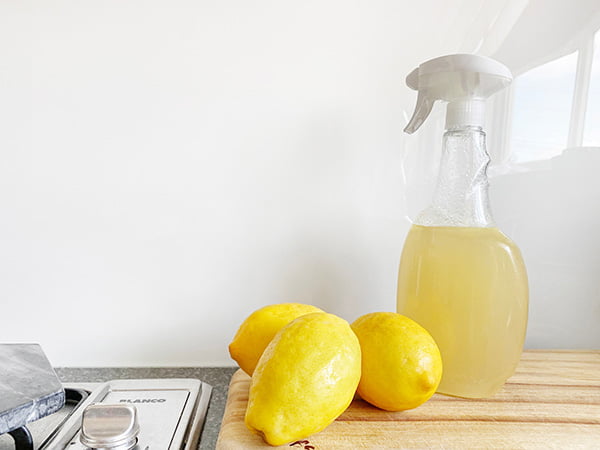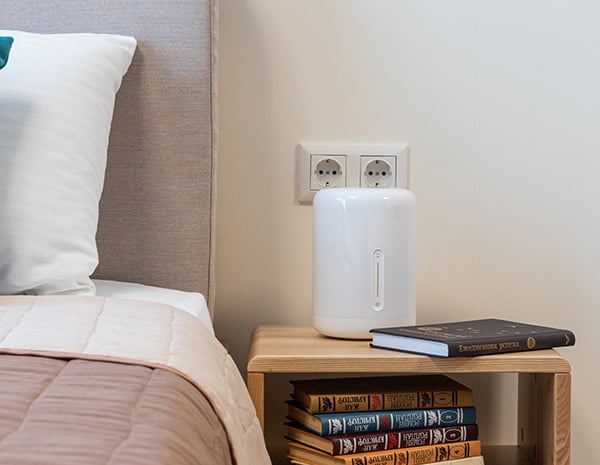Dry air can cause many health issues, ranging from mildly dry skin to asthma attacks. Humidifiers (whole house humidifiers and plant humidifiers) are helpful home appliances because they can maintain the proper air moisture levels in your home. However, like all appliances, there is regular maintenance involved. In fact, you should clean your humidifier on a daily basis!
A well-maintained humidifier will last for many years, but a chronically dirty humidifier or old humidifier should be replaced. Thankfully, it's not hard to keep your humidifier clean. Keep reading to learn how to clean humidifiers without using harsh chemicals so that the air you breathe will be not only properly moist but clean!
Why Is It Important To Clean A Humidifier Regularly?
The task of a humidifier is to add moisture to dry air. This purpose makes it particularly important to keep your humidifier clean, as it can otherwise fill the dry indoor air with mold and other harmful particles. Some of these particles include:
- Bacteria
- Mold spores
- Mineral
- Chemicals
These particles are typically either too small to be seen or appear as white dust. They can irritate the lungs of any healthy person, causing flu-like symptoms and even lung infections. They will particularly cause problems in people with existing breathing issues, asthma, and allergies.
Different Types Of Humidifiers
In order to properly clean a humidifier, it's important to know what type of humidifier is being cleaned and what parts it has.
All humidifiers have some sort of water reservoir or water tank. In order to turn water from the tank into water vapor and circulate the vapor into the air, humidifiers may also consist of a fan, wick, filter, and rotating disks. Different types of humidifiers include:
Central Humidifiers - Just as your furnace or central air unit handles the heating and cooling for your entire home, central humidifiers are installed with the purpose of increasing the air moisture level of an entire building.
Cool Mist Humidifiers - This type of humidifier includes both ultrasonic and portable impeller humidifiers, vaporizing cold water and emitting a cool mist into the air.
Warm Mist Humidifiers - Opposite to cool mist humidifiers, warm mist humidifiers generate steam using a heating element. The steam is then allowed to cool before being released into the air.
Evaporators - Portable and inexpensive, evaporators use a fan to blow water through a wick, belt, or filter.

Image Source: Unsplash
What Cleaning Products You Will Need
Using natural cleaning products to clean your humidifier can be a great choice, as it reduces the chances of introducing harmful chemicals into the air you breathe. Here are some effective natural cleaning products you can use:
White Vinegar: White vinegar serves as a versatile natural cleaning agent, adept at efficiently dissolving mineral accumulations and scale deposits within your humidifier. Additionally, it aids in eradicating any lingering odors. By combining equal amounts of white vinegar and water, you can create a solution that effectively cleanses and descales the various components of the humidifier. Never mix vinegar and bleach together, as it will create toxic gas.
Hydrogen Peroxide: Hydrogen peroxide presents an alternative natural choice for both disinfecting and cleaning your humidifier. Mix equal parts of hydrogen peroxide and water to create a solution. This can help kill bacteria and mold. Make sure to rinse thoroughly after using this solution.
Lemon Juice: Lemon juice has natural antibacterial properties and a pleasant scent. Combining lemon juice with water forms a solution suitable for cleansing and disinfecting your humidifier. Nonetheless, it's important to note that lemon juice carries acidity, necessitating a thorough rinse of the components after the cleaning process.
Baking Soda: Baking soda acts as a mild abrasive capable of eliminating residue and odors from your humidifier. To make use of it, combine a small quantity of baking soda with water to produce a paste, which can then be applied to scrub the various components. Afterward, ensure a thorough rinse.
Essential Oils: Some essential oils, like tea tree oil and eucalyptus oil, possess antimicrobial attributes that contribute to maintaining the cleanliness and freshness of your humidifier. When cleaning, incorporate a few drops of your preferred essential oil into the water tank or base. Be cautious with the amount, as essential oils can be strong.
Castile Soap: Castile soap stands as a gentle and natural cleanser suitable for maintaining the cleanliness of your humidifier. Mix a small amount with water to create a soapy solution, then use it to clean the components. Rinse thoroughly to remove any soap residue.
Distilled Water: Though not primarily a cleaning agent, the utilization of distilled water in your humidifier can effectively reduce the occurrence of mineral accumulation and the necessity for frequent cleaning. Ordinary tap water often harbors minerals that can result in deposits within your humidifier.
How To Clean A Humidifier
- Turn off and Unplug: Prior to initiating the cleaning process, ensure that the humidifier is both deactivated and disconnected from its power source. This precautionary measure guarantees your safety while cleaning.
- Empty the Reservoir: Remove the water tank or reservoir from the humidifier. Drain and discard any remaining water.
- Disassemble: If your humidifier has removable parts, such as a filter, tank cap, or a demineralization cartridge, carefully remove them according to the manufacturer's instructions.
- Rinse and Scrub: Thoroughly rinse the water tank, base, and any detachable components with cold water. Use a soft-bristle brush or toothbrush to delicately remove any mineral deposits or residue. For tougher deposits, you can use a mixture of water and vinegar (1:1 ratio) to soak and loosen the buildup. If the buildup is quite stubborn, let the vinegar solution sit for about 15-30 minutes before scrubbing again.
- Clean the Reservoir: If the reservoir has any small openings or tight spots that are difficult to clean, you can use a mixture of water and mild dish soap to clean them. Make sure to rinse thoroughly afterward to eliminate any lingering soap residue.
- Descale: If your humidifier has mineral scale buildup (white or crusty deposits), you can use a solution of equal parts white vinegar and water to descale the components. Pour the solution into the reservoir and allow it to rest for approximately 30 minutes to an hour, and then scrub away the deposits. Complete the process by thoroughly rinsing with fresh water to eliminate any residual vinegar scent.
- Clean the Base: Using a clean, damp cloth, wipe down the humidifier's base to eliminate dust, dirt, and any residue. Take care to prevent water or moisture from reaching the electrical components.
- Rinse and Dry: Following the cleaning process, thoroughly rinse all components with fresh water to eliminate any remnants of the cleaning solution. Subsequently, permit the parts to air dry completely before reassembling the humidifier. Make sure there's no moisture left, as this can encourage mold growth.
- Reassemble and Refill: Put all the cleaned components back together, ensuring they are properly seated and secured. Refill the water tank with clean, distilled water and reattach it to the humidifier.
- Regular Maintenance: To prevent future buildup, use distilled water in your humidifier to minimize mineral deposits. Furthermore, it's recommended to empty and clean the humidifier at least once a week, particularly when it's in frequent use.

Image Source: Pexels
Tips To Cleaning A Humidifier
Regardless of what type of humidifier you use, keeping bacteria growth, mineral buildup, and mold growth at bay requires both daily cleaning and periodical deeper cleaning. The following steps will guide you through both the daily cleaning and the more thorough cleaning routine.
Follow The Manufacturer's Instructions
Because each humidifier is designed differently, always read the cleaning directions listed in the manufacturer's instructions. It will provide proper guidance to the parts specific to your humidifier. Central humidifiers may require professional servicing.
Use The Correct Products
While there are cleaning products available to purchase that are intended specifically to clean a humidifier, common household products work just as well. Undiluted white vinegar and hydrogen peroxide are effective for regular cleaning. Rinse the humidifier's tank with freshwater any time a cleaning solution is used.
If you have mold growth inside your humidifier, kill the spores with a liquid chlorine bleach solution. Keep in mind, however, to never mix bleach with vinegar in an attempt to boost cleaning power. This produces poisonous chlorine gas.
Have a scrubbing brush on hand to work on any mineral scale buildup, and use a clean cloth to wipe dry after a thorough cleaning.
Wash And Dry Daily
Still water provides a breeding environment for bacteria and mold. Any standing water left in the humidifier tank after each use needs to be emptied out. Rinse the tank with soapy water. Dry the water tank thoroughly before replacing it. Fill the humidifier with fresh water daily.
Use Distilled Water
Whenever feasible, opt for distilled water over tap water when filling your humidifier. Distilled water has the majority of hard minerals removed, which will not only keep these minerals from being released into the air but will also prevent mineral buildup inside the humidifier.
Replace The Filter
The plastic parts and filter in a humidifier may need to be replaced from time to time. Central humidifiers and evaporators, in particular, require regular filter maintenance. The user's manual will provide guidance on how frequently the filter will need to be replaced.
Keep The Surrounding Area Dry
Since humidifiers work by pushing water vapor into the air, it is possible that the area around the humidifier may accumulate moisture. This is particularly true if the humidifier is being used to boost air moisture levels above 50% humidity. Check upholstered furniture, rugs, carpets, and curtains for moisture and mold. If found, remove the humidifier from the area and use white vinegar or diluted bleach solution to treat the mold growth.
Clean Before And After Storage
Humidifiers are sometimes used seasonally when the winter weather makes the indoor air dry. Before storing your humidifier for the season, clean your humidifier thoroughly using vinegar and clean water, and then dry it with a clean cloth. Discard any filters or replaceable components, then store the humidifier in a dry location. You should also clean a humidifier thoroughly when bringing it back out of storage.
